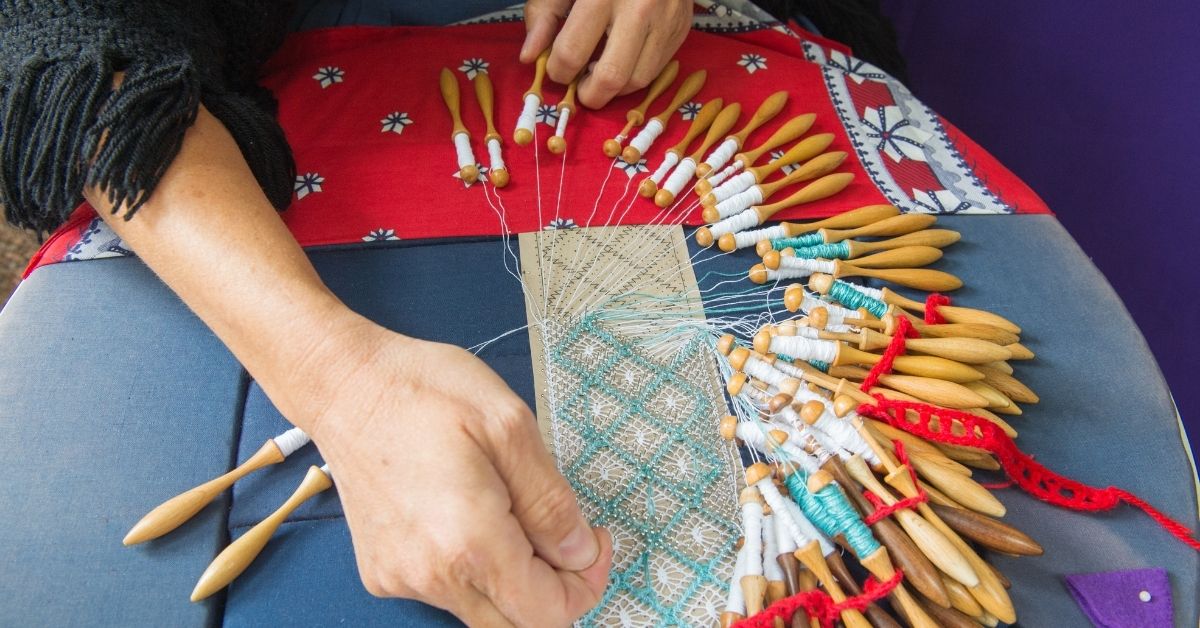Origins and History
This exquisite lacework, known for its delicate patterns and meticulous craftsmanship, draws its name from the Cluny Abbey in France. While it may sound French, Cluny Guipure lace has deep-rooted connections to Spain, where it found its true identity and artistic expression.
The story of Cluny Guipure lace begins centuries ago, but its heart beats to a Spanish rhythm. While its name may evoke images of French abbeys, the artistry of Cluny Guipure truly blossomed on Spanish soil. This unique lace style evolved as Spanish artisans embraced and refined the lace-making techniques introduced from France.
From its early days as a delicate embellishment for ecclesiastical garments in the 19th century, it gradually transformed into a symbol of luxury and refinement. As Spanish fashion embraced lace in the 20th century, Cluny Guipure found its way onto bridal gowns, evening wear, and haute couture, solidifying its status as a timeless classic.
Characteristics of Cluny Guipure Lace
When it comes to textile artistry, Cluny Guipure lace stands as a testament to meticulous craftsmanship and timeless elegance. This exquisite lacework, rooted in Spanish tradition, boasts a set of distinctive features that make it a true masterpiece.
- Intricate Patterns: Known for its intricate and elaborate designs, from florals to geometric shapes, showcasing impeccable craftsmanship.
- Openwork Delight: Its openwork structure creates a stunning contrast between solid and airy sections, adding visual depth.
- Versatile Motifs: Adaptable to a wide array of traditional and modern motifs, making it suitable for various fashion styles.
- Traditional Materials: Crafted with durable, natural materials like cotton and linen threads, ensuring both comfort and longevity.
- Beading and Embellishments: Complements well with beads, sequins, and pearls, allowing for personalized embellishments and added elegance.
Artistic Significance
Crafted with painstaking precision, the artistic craftsmanship involved in creating Cluny Guipure lace is nothing short of awe-inspiring. Every delicate stitch, every intricate motif is a testament to the skilled hands and artistic vision that breathe life into this timeless textile.
Its ethereal beauty and versatility make it a favorite among designers seeking to infuse their creations with a touch of timeless elegance. From bridal gowns that transform dreams into reality to evening wear that sparkles under the spotlight, Cluny Guipure lace has graced the runways of the most prestigious fashion houses, leaving a trail of mesmerized admirers in its wake.
Techniques and Production
Delve into the world of Cluny Guipure lace, and you’ll find a craft steeped in tradition and artistry. Uncover the techniques and production methods that breathe life into this exquisite lace:
- Handwoven Mastery: Using bobbins and a cushion, they deftly intertwine threads to form intricate patterns, connecting the dots of artistry one stitch at a time.
- Lacemaking Pillows: These pillows provide support and allow for easy manipulation of threads, essential for achieving the lace’s intricate designs.
- Knots and Loops: Cluny Guipure lace relies on various knotting and looping techniques, including picots and gimp threads, to create its signature raised patterns.
- Bobbin Lace:. Artisans use numerous bobbins to control the threads and create the lace’s intricate and delicate motifs.
Revival and Contemporary Use
Cluny Guipure lace is a shining example of timeless elegance making a vibrant comeback. Over recent years, there’s been a remarkable resurgence of interest in this exquisite lacework, breathing fresh life into contemporary fashion and design.
Modern fashion collections have been quick to embrace the allure of Cluny Guipure lace, with designers finding ingenious ways to incorporate it into their creations. Renowned designers like Oscar de la Renta and Valentino have skillfully woven Cluny Guipure lace into their collections, rekindling the love affair between fashion and this timeless art form.
Preservation and Conservation Efforts
As time marches on, the craft faces the risk of fading into obscurity. It’s mainly due to the dwindling number of skilled artisans and the demands of a fast-paced modern world. The intricate techniques involved in creating this lace require patience and dedication.
The delicate balance between preserving tradition and adapting to the modern world is a constant challenge. Yet, with the dedication of skilled artisans and the support of conservation organizations, Cluny Guipure lace remains a cherished art form that continues to grace fashion runways and capture the hearts of those who appreciate its timeless beauty.
Conclusion
Cluny Guipure lace stands as a testament to the enduring allure of artistry and tradition. With its roots entwined in Spanish heritage and its intricate patterns meticulously handcrafted, this lacework exudes historical significance like no other. Its delicate motifs, openwork charm, and versatility have allowed it to transcend time. It become a symbol of timeless elegance that spans generations.
FAQs
What is the traditional way of making lace?
Traditional lace making involves intricate handweaving using bobbins and pillows to create delicate patterns, knots, and loops with precision.
What is the use of lace in garment making?
Lace enhances garments by adding decorative elements like edging, overlays, or inserts, elevating their visual appeal.
What are the raw materials for lace making?
Traditionally, lace is crafted from natural fibers like cotton or linen threads. Modern variations may incorporate synthetics for diverse textures.
What is the importance of lace?
Lace carries cultural and artistic significance, symbolizing craftsmanship and timeless elegance, enriching fashion, art, and textiles.
What tool is used to make lace?
Essential tools for lace making include bobbins, cushions, pillows, and a variety of needles, enabling thread control and pattern intricacy.
Where is the best lace made?
High-quality lace is produced globally, with renowned lace-making countries like Belgium, France, Italy, and Spain, each offering unique traditions and styles.












